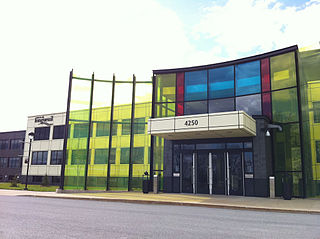
Longueuil is a city in the province of Quebec, Canada. It is the seat of the Montérégie administrative region and the central city of the urban agglomeration of Longueuil. It sits on the south shore of the Saint Lawrence River directly across from Montreal. The population as of the Canada 2016 Census totalled 239,700, making it Montreal's second largest suburb, the fifth most populous city in Quebec and twentieth largest in Canada.
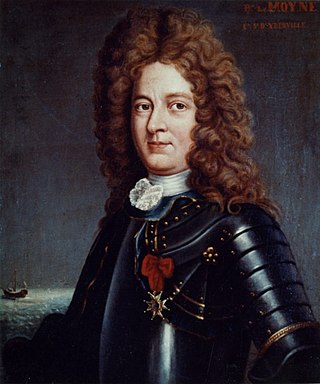
Pierre Le Moyne d'Iberville or Sieur d'Iberville was a French soldier, explorer, colonial administrator, and trader. He is noted for founding the colony of Louisiana in New France. He was born in Montreal to French colonist parents.
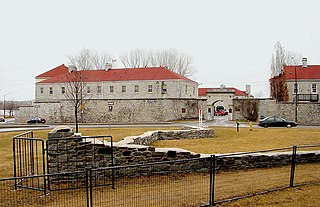
Fort Frontenac was a French trading post and military fort built in July 1673 at the mouth of the Cataraqui River where the St. Lawrence River leaves Lake Ontario, in a location traditionally known as Cataraqui. It is the present-day location of Kingston, Ontario, Canada. The original fort, a crude, wooden palisade structure, was called Fort Cataraqui but was later named for Louis de Buade de Frontenac, Governor of New France who was responsible for building the fort. It was abandoned and razed in 1689, then rebuilt in 1695.

Le Moyne is a neighbourhood in Longueuil, Quebec, part of the borough of Le Vieux-Longueuil, and a former city. Le Moyne makes up 2% of the total area of Le Vieux-Longueuil borough and is the only neighbourhood of the borough that was not part of the pre-2002 city of Longueuil. Residents of Le Moyne are called Le Moynois.
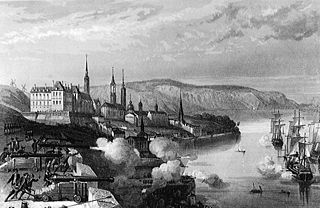
The Battle of Québec was fought in October 1690 between the colonies of New France and Massachusetts Bay, then ruled by the kingdoms of France and England, respectively. It was the first time Québec's defences were tested.

Baron de Longueuil is a title of French nobility that was granted originally by King Louis XIV of France to a Norman military officer, Charles le Moyne de Longueuil. Its continuing recognition since the cession of Canada by France to Britain is based on the Treaty of Paris (1763), which reserved to those of French descent all rights which they had enjoyed before the cession.

Antoine Juchereau Duchesnay was the Seigneur of Beauport, Saint-Denis, Fossambault, Gaudarville, and Saint-Roch-des-Aulnaies. He fought with the Troupes de Marine and after the British Conquest of New France joined the British Army, defending Fort Saint-Jean where he was captured and imprisoned by the Americans in 1775. He represented Buckingham County in the 1st Parliament of Lower Canada and was afterwards appointed a member of the Executive Council of Lower Canada.

Charles le Moyne de Longueuil et de Châteauguay, was a French officer and merchant who was a prominent figure in the early days of Montreal. Born in Dieppe, France in Normandy, he came to New France in 1641. He became lord of Longueuil in Canada.

Montreal-South was a suburb of Montreal located on the south shore of the St. Lawrence River founded in 1906. Montréal-Sud was created from land of the Saint-Antoine-de-Longueuil parish. Originally a village in its first five years, Montréal-Sud gained the status of city in 1911.
Jacques Le Ber was a merchant and seigneur in Montreal, New France. In 1686 he was ennobled by Louis XIV and took the title Jacques Le Ber de Saint-Paul de Senneville, based on his hometown of Senneville-sur-Fécamp.
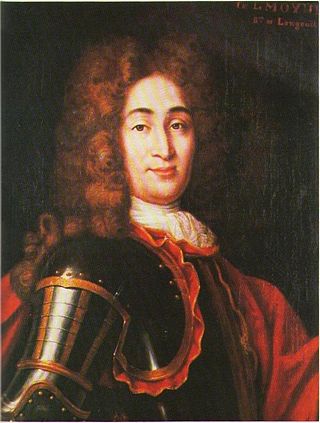
Charles (II) le Moyne de Longueuil, Baron de Longueuil was the first native-born Canadian to be made Baron in New France.
Jean Bochart de Champigny, Sieur de Noroy et de Verneuil, chevalier, was Intendant of New France from 1686 to 1702. He was the son of Jean Bochart de Champigny, intendant of Rouen, and Marie Boivin.
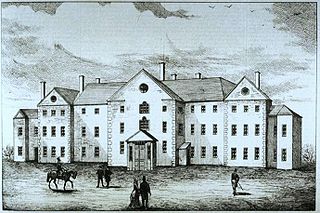
The Chateau St. Louis in Quebec City was the official residence of the French Governor of New France and later the British Governor of Quebec, the Governor-General of British North America, and the Lieutenant-Governor of Lower Canada.

Old Longueuil is a historic neighbourhood located in the borough of the same name, in the city of Longueuil, Quebec, Canada. There is not a universal definition of what exactly constitute the Old Longueuil neighbourhood, but it always includes at least the territory corresponding to the pre-1961 city of Longueuil.

The Co-Cathedral of Saint-Antoine-de-Padoue is a co-cathedral in Longueuil, Quebec, Canada, on Montreal's south shore. It is located on the corner of Rue Saint-Charles and Chemin Chambly in the Borough of Le Vieux-Longueuil. It is dedicated to St. Anthony of Padua. The cathedral houses the remains of the Blessed Marie-Rose Durocher, the foundress of the Sisters of the Holy Names of Jesus and Mary.

Captain François-Marie Renaud d'Avène des Méloizes was a French Cavalry officer who came to New France in 1685 in command of the Troupes de Marine and led the successful expedition against the Senecas. The Comte de Frontenac considered him "one of the best and wisest officers" in Canada. He is buried in the vaults of Notre-Dame Basilica-Cathedral, Quebec City.

Charles III Le Moyne (Longueuil, was the second baron de Longueuil. He succeeded his father Charles le Moyne de Longueuil, Baron de Longueuil in 1729. He became Governor of Montreal, and administrator by interim of New France

Longueuil—Charles-LeMoyne is a federal electoral district in Quebec, Canada, that has been represented in the House of Commons of Canada since 2015. It encompasses a portion of Quebec formerly included in the electoral districts of Saint-Bruno—Saint-Hubert and Saint-Lambert.
Paul-Joseph Le Moyne de Longueuil was a seigneur and colonial army officer in New France and governor of Trois-Rivières from 1757 to 1760.
Joseph-Dominique-Emmanuel Le Moyne de Longueuil was a soldier, seigneur and politician in New France and Quebec.
















